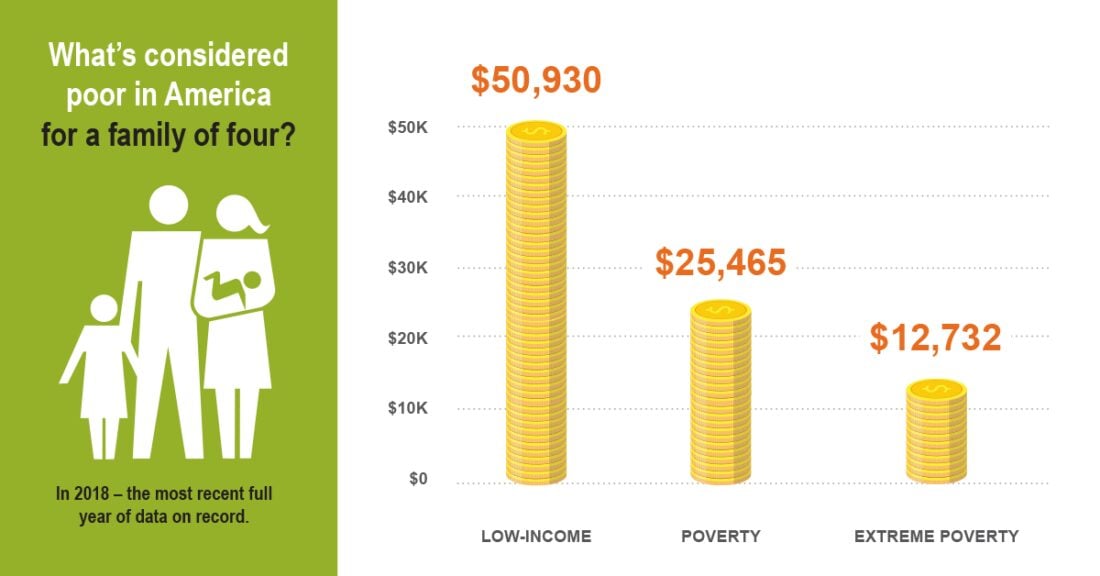Poverty Talk: Basic Terms You Need to Know Now

Experts talk about poverty in various ways. This post explains some of the most common terms used to describe poverty in the United States today.
Two Main Measures of Poverty
There are two federal measure of poverty in the United States: the official poverty measure and the supplemental poverty measure.
In 2018, 13% of Americans — 42 million people — lived in poverty according to the official definition of poverty. This measure estimates an 18% child poverty rate, translating to 13 million kids living in poverty in 2018.
That same year, 13% of Americans — about 42.5 million people — lived in poverty according to supplemental poverty measure. This calculation estimates a 15% child poverty rate, translating to about 10.7 million kids living in poverty in 2018.
The Official Poverty Measure
The U.S. Department of Health and Human services uses the official poverty measure to determine eligibility for government programs.
Income thresholds for this measure are calculated by tripling the inflation-adjusted cost of the minimum food budget in 1963 and amending for family size and composition. A family or an individual is considered poor if their household earnings fall below their prescribed annual income threshold.
In 2018, some of these thresholds were:
- $29,967 for a family of five with three children.
- $25,465 for a family of four with two children.
- $20,231 for a family of three with two children.
The Supplemental Poverty Measure
Developed in 2010, the supplemental poverty measure offers a more statistically complex estimate of poverty and speaks to how government safety net programs are impacting poverty rates.
Unlike the official poverty measure, which defines a family’s income as their pre-tax cash earnings, the supplemental poverty measure considers a broader set of resources. It counts in-kind benefits, such as food and housing assistance, as well as safety net benefits, such as the Earn Income Tax Credit. It also subtracts necessary expenditures, such as child care, and medical expenses.
Income thresholds for this measure extend beyond food costs and consider the costs of basic goods and necessities, such as clothing and shelter. Thresholds vary by location and housing arrangements and can expand the family unit to include non-related members who share household resources.
In 2018, some of these thresholds were:
- $28,342 for a family of four with two children and a home mortgage payment.
- $28,166 for a family of four with two children and a rent payment.
- $24,173 for a family of four with two children and no home mortgage payment.
Comparing the Two Federal Poverty Measures
| Official | Supplemental | |
|---|---|---|
| Used to determine eligibility for government assistance programs | Yes | No |
| Estimated annually based on a sampling of U.S. households | Yes | Yes |
| Varies geographically | No | Yes |
| Adjusted over time to reflect changing patterns of consumption | No | Yes |
| Accounts for non-related cohabitators and their families as well as foster children | No | Yes |
| Considers different housing arrangements, such as having a mortgage payment versus renting a home | No | Yes |
| Considers money income from all sources, including government programs and tax credits | No | Yes |
Degrees and Types of Poverty
Extreme Poverty
Families live in extreme poverty when their household earnings amount to less than half of their assigned poverty threshold. Also written as “below 50% poverty,” this designation applied to 17.3 million Americans in 2018.
In 2018, some thresholds for extreme poverty were:
- $14,983 for a family of five with three children.
- $12,732 for a family of four with two children.
- $10,115 for a family of three with two children.
Nearly half — 45.3% — of America’s poor lived in extreme poverty in 2018, according to U.S. Census Bureau data. Children are more likely to experience extreme poverty than adults; 5.7% of Americans, including 8% of all children, lived in extreme poverty in 2018.
Low Income
To meet their most basic needs, families need to earn about twice as much as the federal poverty threshold, according to research. Families with annual earnings below this level — $50,930 for a family of four with two children in 2018 — are considered low income.
Also written as “below 200% poverty,” this designation applied to 39% of all children — nearly 28.5 million kids total — in 2018.
Concentrated Poverty
Areas of concentrated poverty — also called high-poverty areas — are census tracts where poverty rates for the local population hits 30% or higher.
Compared to more affluent areas, high-poverty neighborhoods are more likely to have high rates of crime, violence, health issues and unemployment.
The most recent data on record indicate that 8.5 million children — 12% of kids nationwide — lived in areas of concentrated poverty from 2013 to 2017, according to the KIDS COUNT Data Center.






